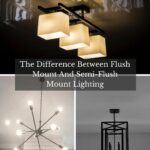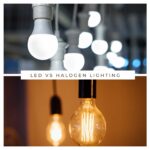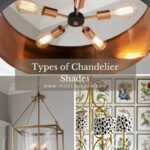Ceiling lights and their fixtures add a special touch to the design of any room.
As well as their aesthetic, ceiling lights are designed with specific purposes in mind; they illuminate rooms from above, as they are affixed to the ceiling.
Because lights are a permanent feature and have important practical purposes, you don’t want to make a costly mistake right at the start of decorating your house!
There are therefore several important considerations to be aware of when choosing ceiling lights.
If you’re wondering how to choose the best ceiling lights for your home, keep reading to learn more about the many different types, their functions, as well as their features and attributes!
What are the Different Types of Ceiling Lights?
| Ceiling-Mounted Lights | Hanging Ceiling Lights |
| Flush Lights | Pendant Lights |
| Semi-Flush Lights | Inverted Pendant Lights |
| Recessed Lights | Chandeliers |
| Utility Lighting | Track and Rail Lighting |
| LED Indirect Lighting | Island Lighting |
There are many different types of ceiling lights. In this section, we’ll discuss what they are, their features, how they look, how they work, and where they are commonly used.
Here are the different types of ceiling light:
1. Ceiling-Mounted Lights
Ceiling-mounted lights offer ambient lighting and different shades of light for average- to large-sized rooms.
Ceiling mounted lights can be flush (with no space between the ceiling and the light fixture) or they can be semi-flush (with a gap between the two).
Flush Lights
Flush lights are flat and mounted to the ceiling. Smaller flush lights are a good choice for bathrooms and hallways. Larger flush lights are better for nurseries or children’s rooms.
Flush lights suit rooms where the ceiling is not too high, otherwise they can make a room look like it has too much empty space.
Something else to bear in mind is that the bulb that you choose to go with this fixture should be bright– it has to light up a whole room, after all!
Semi-Flush Lights
Semi-flush lights will usually hang between four and eight inches below the ceiling.
These lights are a practical solution for kitchens and dining rooms because they direct light downwards while simultaneously lighting up the ceiling. The effect of this is to add depth to a room.
Recessed Lights

Recessed lights are mounted in the ceiling. You need to have at least 6 inches of ceiling space and sufficient insulation to use the recessed light fixture.
As a discrete source of light, recessed lights provide great ambient lighting.
Some types are directional, meaning you can adjust the light’s direction to highlight features of the room. This makes them a good choice for task lighting as well.
Recessed lights can be used in both large and small spaces, and they’re often featured in rows. Just a tip: They look great on low ceilings!
Utility Lighting
This is the most basic of all lighting types discussed in this article.
Utility lights are mounted flush to the ceiling or LED bulb casings. They are a general-purpose light– but as the name suggests, they are ideal for garage, laundry, and workshop areas.
This is a simple, effective option that offers bright light for getting the job done!
LED Indirect Lighting
LED (Light-Emitting Diodes) indirect lighting consists of rows of LED lights in the ceiling. This sort of lighting makes the room appear larger than it is. You can also get color-changing LED lights which suit modern rooms.
Installing LED lighting is a very cost effective solution, as LED lights are more efficient than standard incandescent bulbs.
2. Hanging Ceiling Lights
Hanging ceiling lights are best for task lighting– If you’re reading or doing needlework, for example. They are also a good choice for ambient lighting.
Hanging ceiling lights direct light to a small area. They are hung from the ceiling, as their name suggests!
Hanging ceiling light fixtures are particularly ornate, and are crafted for display rather than utility purposes.
Pendant Lights

Pendant lights hang low from the ceiling, and are used with flush fixtures to add more light to an area. You often see them used in rows of lights, and can make small rooms appear bigger.
They are pleasant lights to open up hallway areas as well, to make them appear more welcoming.
This type of fixture should be chosen to match the décor of the room, as their height makes them quite obvious.
Inverted Pendant Lights
As a variation on pendant lights, inverted pendant lights are excellent for kitchen islands and bedrooms to provide ambient lighting. Their design is as a pendant light, but remodeled and inverted.
Whereas pendant lights are often shaped like an upside-down bowl, inverted pendant lights resemble more closely an upright bowl, suspended from the ceiling!
Chandeliers
Chandeliers offer that old-school type of classiness. They are used in areas that you want to show off, such as living rooms and dining rooms.
However, it is important to get the height right so that you don’t make the room look too small. At the same time, you also do not want them to hang too low– else taller people might hit their heads on them!
Traditionally, chandeliers were hung on chains, as their weight gave them need for a heavy support fixture. Some of the modern chandeliers have a suspension fixture instead of a chain for this purpose.
If you want more lighting, look for a chandelier with more branches; however, if you are using them in a small bedroom for example, then you might want to choose one with just two or three.

Finally, to make a small room look bigger, choose a chandelier with uplights.
Track and Rail Lighting
Track lighting is one of the more affordable options for modern settings. It consists of a row of lights hanging from a track.
Track and rail lighting is best for accent or task lighting. The track can be mounted on the ceiling, or suspended from it.
Some tracks allow for directional lighting too, which is good for the kitchen, bathroom or study areas. You can hang pendant lights from a track as well.
Rail lighting is like track lighting, but it is more directional as it allows for movement in the shape and position of the rail. Rail lighting is used for small areas such as corners for task lighting.
Island Lighting
Island lighting is designed to hang low over specific areas such as kitchen islands, workshop benches or desks.


This sort of lighting is often a stylistic feature in itself, but it is also very practical! You often see island lighting in interior design magazines and show homes.
Different Types of Materials for Ceiling Lights

Now that you have an idea of the range of options, it’s time to learn about the materials that are most often used in creating overhead lighting fixtures.
The type of material used for the light fixture will be one of the most important factors in determining whether or not the fixture works with the rest of the decor.
It’s important to keep in mind function and aesthetics. The lights you choose will depend on which room they are for, what type of lighting you need for that room– and of course, your style preferences!
1. Glass Ceiling Lights
Glass ceiling lights are popular because glass diffuses light, which makes it ideal material for light fixtures in most rooms.
Or, to put it another way: There are very few places where glass does not look good in ceiling lights!
Flush and recessed lights are made from glass. Often, semi-flushed and pendant lights are made from glass as well.
Glass can be relatively understated to blend in with its surrounding; you could also use colored glass to make a bolder statement.
2. Fabric Light
Fabric looks informal and relaxing. It works well in bedrooms, living rooms, and dining rooms in flush and semi-flush lights with a fabric shade.
Consider the color of the fabric shade when determining the mood or atmosphere you want to set for the room.
3. Crystal Light
Crystal is a fine choice for chandeliers, semi-flush fixtures, and pendant lights. It usually costs more than the other options discussed here.
The fixture is either made from actual crystals of various types, or it is created from a synthetic, lookalike material for a similar diffusive effect.
It is a particularly beautiful feature because the crystal reflects light in ways that glass and fabric both do not. Crystal is often seen in dining rooms in chandeliers.
4. Metal Ceiling Lights
Metal would not have been considered even a decade ago, but it is now a stylish twist on modern decor.
Metal ceiling lights are used in track and rail lights in bathrooms and you also see them in industrial kitchen designs, especially in kitchen islands.
Important Things to Keep in Mind Before Buying Ceiling Lights

You probably have a preference for ceiling lights. Of the types that we have discussed, one or two will definitely appeal to you more than others.
To help you weigh up what kind of lights you want, there are a couple of other things that you should take into account:
Consider the Size of the Room
You will need to consider what type of ceiling light functions best for different areas of your home.
Think about the size of the area that you are lighting, as well as the design and purpose of the room. For example, a crystal chandelier in a small room may look too “busy” and may not be ideal as bedroom ceiling lights!
What Will You Use the Light for?
There are three main uses for lighting: Ambient, task, and accent.
You should definitely have ambient lighting, as well as some specific accent lighting and task lighting suited to the look of the room and whatever purpose the room is for.
1. Ambient Lighting
Ambient lighting ensures an overall brightness, so this sort of lighting should be in the center of the room.
Ambient lighting is usually soft or diffuse. It is best for indoor entrance areas such as halls and stairs, but it is good in kitchens and study areas too.
Ambient light comes in the form of ceiling-mounted or recessed lights, wall sconces, and floor lamps, cove lights, and pendant lights.
2. Task Lighting
You can add task-specific lighting such as lamps that you can adjust as needed.
Task lighting is necessary for tasks requiring close reading, or extra light that you can switch on and off over bathroom mirrors (for when you are applying cosmetics).
Task lighting is important because without it, you can get eye strain easily! This light is directed at the area where you are working, and is brighter than ambient lighting.
Task lighting comes in the form of recessed and track lighting, pendants, under-cabinet lighting, lamps (floor, desk, and table), and bathroom vanity lights.
You’ll often see task lighting in kitchens as under-cabinet lighting or pendants over food prep areas.
3. Accent Lighting
Accent lighting is used over items or areas that you want to draw attention to, such as paintings.
This is why you often see this sort of lighting in art galleries in the form of directed downlights. These lights are also very suitable for entrances.
Accent lights are brighter than ambient lights, and ideally, you should get them with adjustable fittings that can be turned to highlight the features that you want to showcase.
Types of accent lights include: Wall-mounted lights, track lights, and recessed lights.
Get the Right Type of Bulbs
There are so many options available to you these days and yet, some of the traditional ones are no longer available!
Basically, you’ll want to choose the right kind of bulbs because lighting accounts for at least 10% of your overall electricity bill.
At the same time, you need to balance this with the lighting requirements for your place.
Keep in mind the following:
Lumens:
Bulb light output is now discussed in lumens, not watts.
Compact fluorescent lamps (CFL) bulbs have high lumen output. CFLs cost more, but they have a long life (5-10 times longer than a halogen bulb) and they use less 25% of the energy of a halogen lamp- ideal for energy conservation!
Mood or Color Temperature:
Warm white lights are suitable for your living room and bedrooms, whereas cool white is best for kitchen ceiling lights and home workspaces such as offices, workshops, and garages.
Daylight bulbs imitate natural light but as a colder light, they can be too intense for rooms other than the bathroom or laundry room.
The Bottom Line
Choosing between all the different types of traditional and modern ceiling lights is an exciting part of home improvement. There are so many more options available today than there used to be!
You can choose fixtures that are flush, semi-flushed, or recessed. The lights themselves can be LED, pendant, or even inverted pendants!
Traditional chandeliers are still available, along with newer options such as track, rail, and island lighting.
For the material of your flush ceiling lights, metal, glass, fabric, and crystal are popular.
Finally, when choosing ceiling lights and bulbs, don’t forget to consider the size of the room, the style of your décor, and what kind of room it is– whether the kitchen, bathroom, or bedroom!







